Research
‘Two-phase or not two-phase’
Applying two-phase flow and reactive thermodynamics at tectonic boundaries to understand Earth dynamics through its evolution. Fluid dynamic applications to planetary systems with a goal to understand potential habitability. Tackling modern day problems such as carbon storage and monitoring.
Mid-ocean ridges
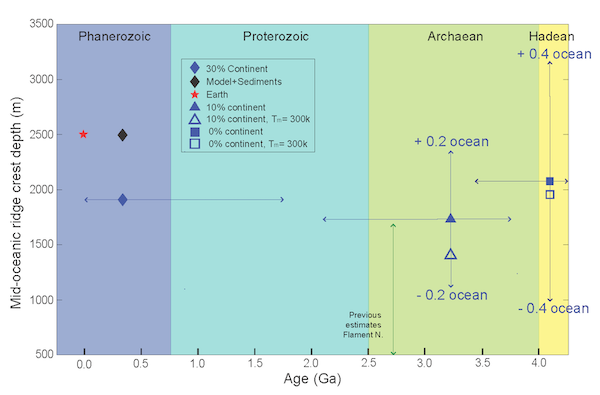
Early Earth
The interconnectedness of life, water, and plate tectonics is strikingly apparent along mid‐ocean ridges (MOR) where communities of organisms flourish off the disequilibrium of chemical potentials created by circulation of hydrothermal fluids driven by Earth’s heat. Moreover, submarine hydrothermal environments may be critical for the emergence of life on Earth. Oceans were likely present in the Hadean but questions remain about early Earth’s global tectonics, including when seafloor spreading began and whether mid‐oceanic ridges were deep enough for maximum hydrothermal activities. For example, plate tectonics influences global sea level by driving secular variations in the volume of ocean basins due to continental growth. Similarly, variations in the distribution of seafloor age and associated subsidence, due to assembly and dispersal of supercontinents, explain the largest sea level variation over the past 140 Myr. Using synthetic plate configurations derived from numerical models of mantle convection appropriate for early Earth, we show that MOR have remained submerged and their depths potentially constant over geologic time. Thus, conditions in the early Earth existed for hydrothermal vents at similar depths as today, providing environments conducive for the development of life and allowing for processes such as hydrothermal alteration of oceanic crust to influence the mantle’s geochemical evolution. [Sim et al 2016].
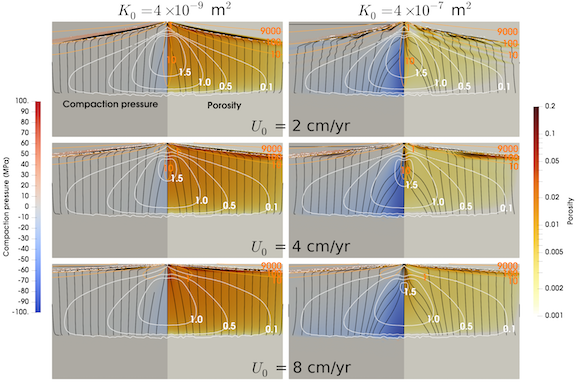
Melt transport at modern mid-ocean ridges
At mid-ocean ridges, oceanic crust is emplaced in a narrow neovolcanic region on the seafloor, whereas basaltic melt that forms this oceanic crust is generated in a wide region beneath as suggested by a few geophysical surveys. The combined observations suggest that melt generated in a wide region at depths has to be transported horizontally to a small region at the surface. We present results from a suite of two-phase models applied to the mid-ocean ridges, varying half-spreading rate and intrinsic mantle permeability using new openly available models, with the goal of understanding melt focusing beneath mid-ocean ridges and its relevance to the lithosphere-asthenosphere boundary (LAB). Three distinct melt focusing mechanisms are recognized in these models: 1) melting pressure focusing, 2) decompaction layers and 3) ridge suction, of which the first two play dominant roles in focusing melt. All three of these mechanisms exist in the fundamental two phase flow formulation but the manifestation depends largely on the choice of rheological model. The models also show that regardless of spreading rates, the amount of melt and melt transport patterns are sensitive to changes in intrinsic permeability, K0. In these models, the LAB is delineated by the melt-rich decompaction layers, which are essentially defined by the temperature dependent rheological and freezing boundaries. Geophysical observations place the LAB at a steeper incline as compared to the gentler profile suggested by most of our models. The models suggest that one way to reconcile this discrepancy is to have stronger melting pressure focusing mechanism as it is the only mechanism in these models that can focus melt before reaching the typical model thermal LAB. The apparent lack of observable decompaction layers in the geophysical observations hints at the possibility that melting pressure focusing could be significant. These models help improve our understanding of melt focusing beneath mid-ocean ridges and could provide new constraints for mantle rheology and permeability. [Sim et al 2020], Carnegie video highlights for AGU 2019, Geodynamics and Tectonics Virtual Seminar, Invited seminar at University of Maryland, Github repository for model inputs

Porosity waves mid-ocean ridges
Our understanding of oceanic crustal formation is mostly limited to observations of young crust formed in the past several million years, due to the thick sediments on older crust and the remote location of many spreading centers. Here we use 40 m-resolution bathymetric data collected over hundreds of square kilometers during the search for Malaysia Airlines Flight 370 on the flank of the Southeast Indian Ridge, which provides a record of crustal accretion from 11–23 Ma. Spectra calculated from the data show a characteristic timescale of 300–400 kyr and no evidence for periodicity coinciding with glacial cycles. This characteristic timescale could be explained by fluctuations in melt supply and the amount of faulting, leading to variations in crustal thickness. We show that this timescale of variation is consistent with porosity waves observed in a two-phase flow model, which persist over millions of years. [Parnell-Turner, Sim and Olive 2020]
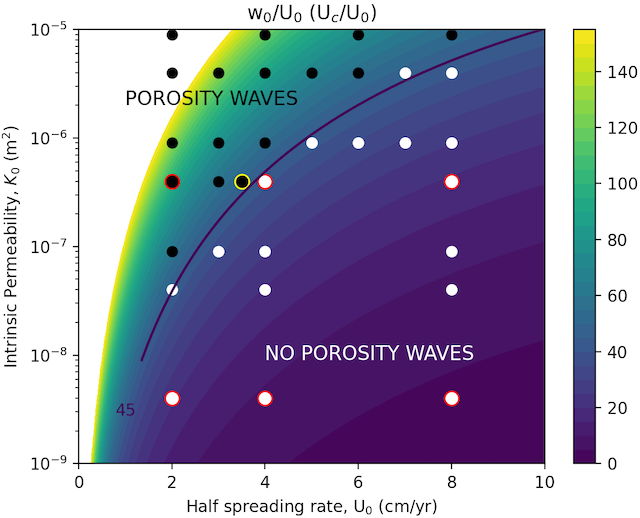
The ocean floor makes up the majority of the Earth’s surface and yet, its geomorphology is not fully understood. Recent debate has focused on whether sea level changes—driven by Milankovitch glacial cycles—generate the abyssal hill fabric of the ocean floor by modulating mid-ocean ridge magma supply. However, periodicities longer than Milankovitch cycles are prominent in the ocean bathymetry. Using crustal thickness estimates from two-phase flow simulations of ridge magma transport, I show that persistent melt-rich porosity waves could be responsible for the ocean floor fabric at periods of 100 kyr and longer, except in the case of fast-spreading ridges. For periods longer than 100 kyr, spectral energy is notably present at large mantle permeabilities regardless of spreading rates. Therefore, two-phase flow models can provide constraints on elusive mantle parameters such as permeability and viscosity when directly linked to the ocean floor fabric produced. Sim 2022
Subduction zones
Carbon potential at subduction zones
In the deep carbon cycle, the largest contributor of CO2 to the atmosphere are both diffused and concentrated emissions from the subduction zone system. The changing amount of CO2 in the atmosphere affects long term global climate that may be a positive feedback mechanism with tectonic activities. The main potential source for carbon emitted in the arc system is carbonate that enters the subduction zone as seafloor sediments and altered ocean crust. The traditional view of the fate of this carbon after subduction is that most of it is carried into the deep mantle past the subduction zone, due to its high decarbonation temperature and predicted low solubility in H2O-rich fluids. However, recent experimental and thermodynamic modeling of carbon solubility in aqueous fluids at high pressure and temperature settings suggest that a substantial amount of carbon can be carried by aqueous fluids released from the oceanic lithosphere. In this work, we use the carbon solubility model from Kelemen & Manning 2015 (based on DEW, Sverjensky et al 2014) and apply it to a global suite of subduction zone convection models with the goal of understanding the the potential for carbon storage in the mantle wedge. The results presented give us an idea of where carbon species might be dissolved, deposited or stored as aqueous fluids released from the subducting slab move through the mantle wedge. Carnegie video highlights for AGU 2019
Eclogitization of continental lithosphere from subduction zone devolatilization
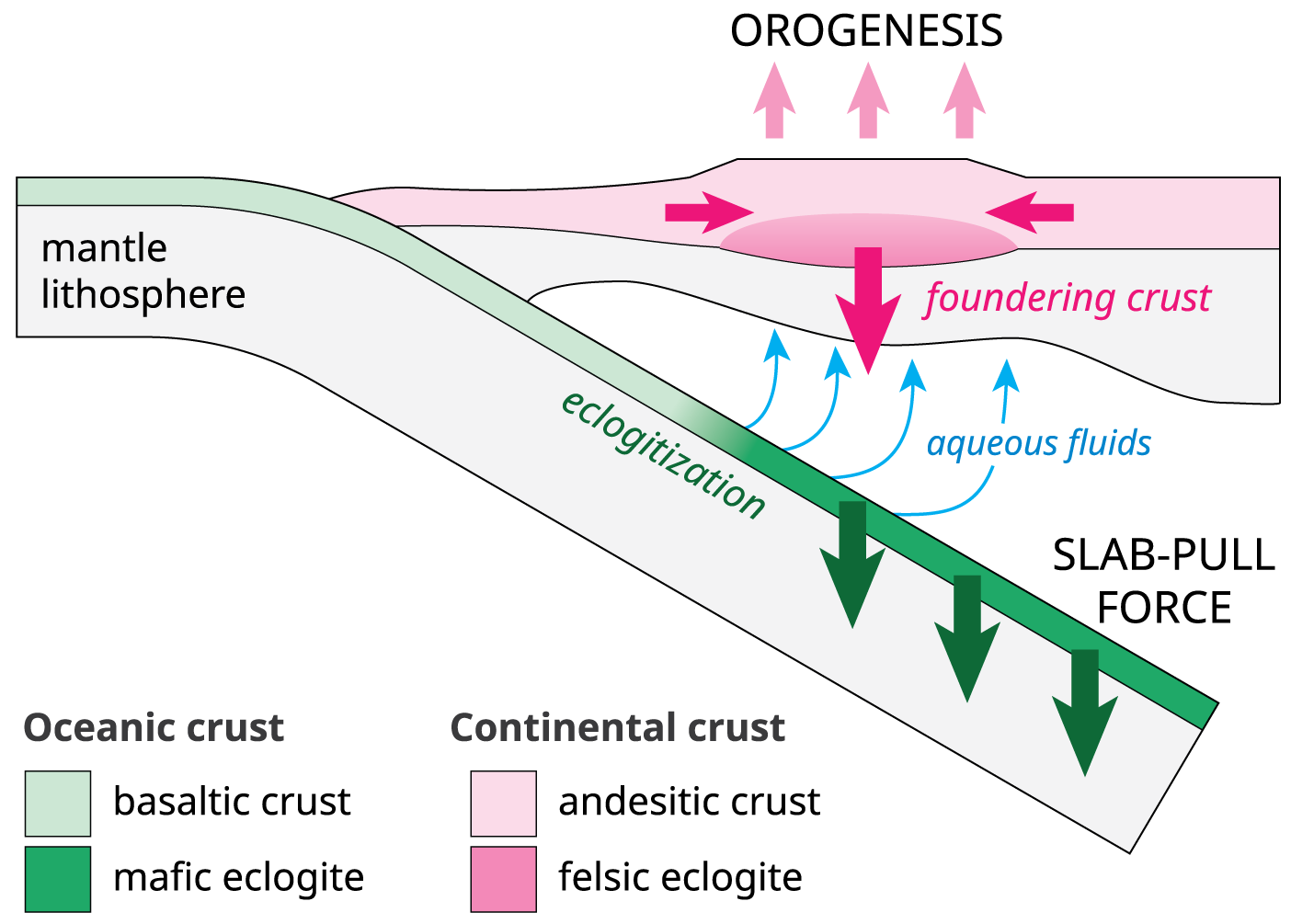
Subduction zones are regions where one tectonic plate slides and sinks beneath another, and they have been a major focus of research in the field of Earth Science due to their association with mountain-building and with natural hazards like earthquakes and volcanic eruptions. Improving the understanding of processes involving the sinking of these rocks into the Earth’s interior, known as foundering, holds valuable insights for subduction zones and continental crust research. The foundering process requires the rocks are of greater density than their surroundings. This project will explore the processes controlling the transformation of rocks in the lower continental crust to greater density resulting from mineral transformations and the degree to which the process requires fluid-mediated reactions common in subduction zones. The results of this modeling study will be compared to rocks found in Norway that are thought to have returned to the surface after undergoing this densification process. This project seeks to address a notable knowledge gap concerning the mechanisms behind mountain-building processes beneath the Earth’s surface, known as orogenesis. The primary focus of this project is on understanding the role of reactive fluids and the thermodynamics of eclogitization in the deep crust. To accomplish this, the project aims to develop advanced models that integrate the thermodynamics of eclogitization with simulations of fluid flow. These models will enable researchers to investigate the interactions between fluids and the eclogitization process and determine the timescales associated with metamorphism and the sinking of the lithosphere. The project will consist of two interconnected numerical modeling studies. First, models of disequilibrium thermodynamics will be developed to capture the behavior of key mineral phases and reactions. These models will then be coupled with simulations of fluid flow and rock deformation. To validate and gain insights from the models, the researchers will compare the model outputs with the grain-scale to regional-scale structures observed in well-documented eclogites from Norway. This analysis will allow them to test the hypothesis that lithospheric foundering is a global phenomenon and a consequence of orogenesis. Moreover, the models will provide valuable information about the specific conditions under which eclogitization becomes thermodynamically favorable and the timescales required for significant accumulations of eclogite in the lower crust. The researchers will explore these processes across a diverse range of initial rock compositions, representing the wide variety found in the Earth’s continental crust. Ultimately, the project aims to enhance our overall understanding of the complex metamorphic and metasomatic processes that occurs during mountain formation.
Cryosphere and planetary systems
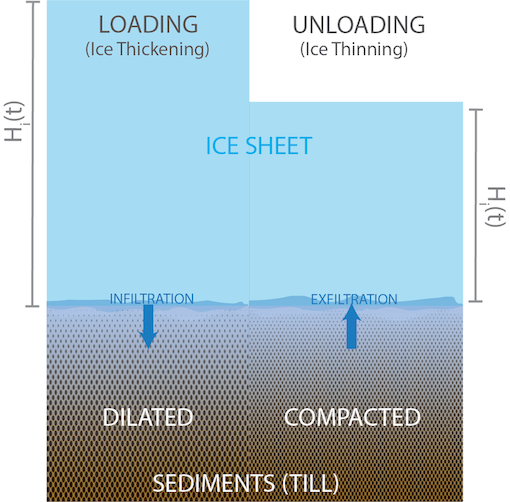
Exfiltration of ground water beneath thinning Antarctic ice sheets
The two-phase flow formulation applies to many environments including the icy poles on Earth and water worlds. Collaborations at Georgia Tech has led to the understanding of the potential for groundwater exfiltration beneath the thinning Antarctic ice sheets. Groundwater-laden sedimentary aquifers are extensive beneath large portions of the Greenland and Antarctic ice sheets. With a simple theory, it is shown that as the ice sheets thin, there is a potential for exfiltration that can be a dominant component of the subglacial water budget. Continued Antarctic Ice Sheet thinning over the coming decades to centuries guarantees that the role of exfiltration in the basal water budget will only continue to grow into the future, suggesting the need to develop better integrated models of interactions between subglacial groundwater and drainage.

Melt water transport in icy shell of ocean worlds to understand potential habitability
Similar to ice on Earth, there are icy environments in other planetary systems such as on the moons of Jupiter, Ganymede or Europa. NASA Europa Clipper Mission has a launch date on October 2024 and will reach Jupiter orbit around 2030. Europa has diameter about a quarter that of Earth but has a relatively sizable water body that has been hypothesized to potentially host life. Europa has an icy surface estimated to be around 3-30km thick with an liquid salty ocean beneath followed by a rocky floor. The icy surface layer has been hypothesized to transport materials between the ocean and the surface in various ways including two-phase flow transport briny water. We aim to simulate this transport in the hopes to better understand this exchange and help guide the Clipper mission.
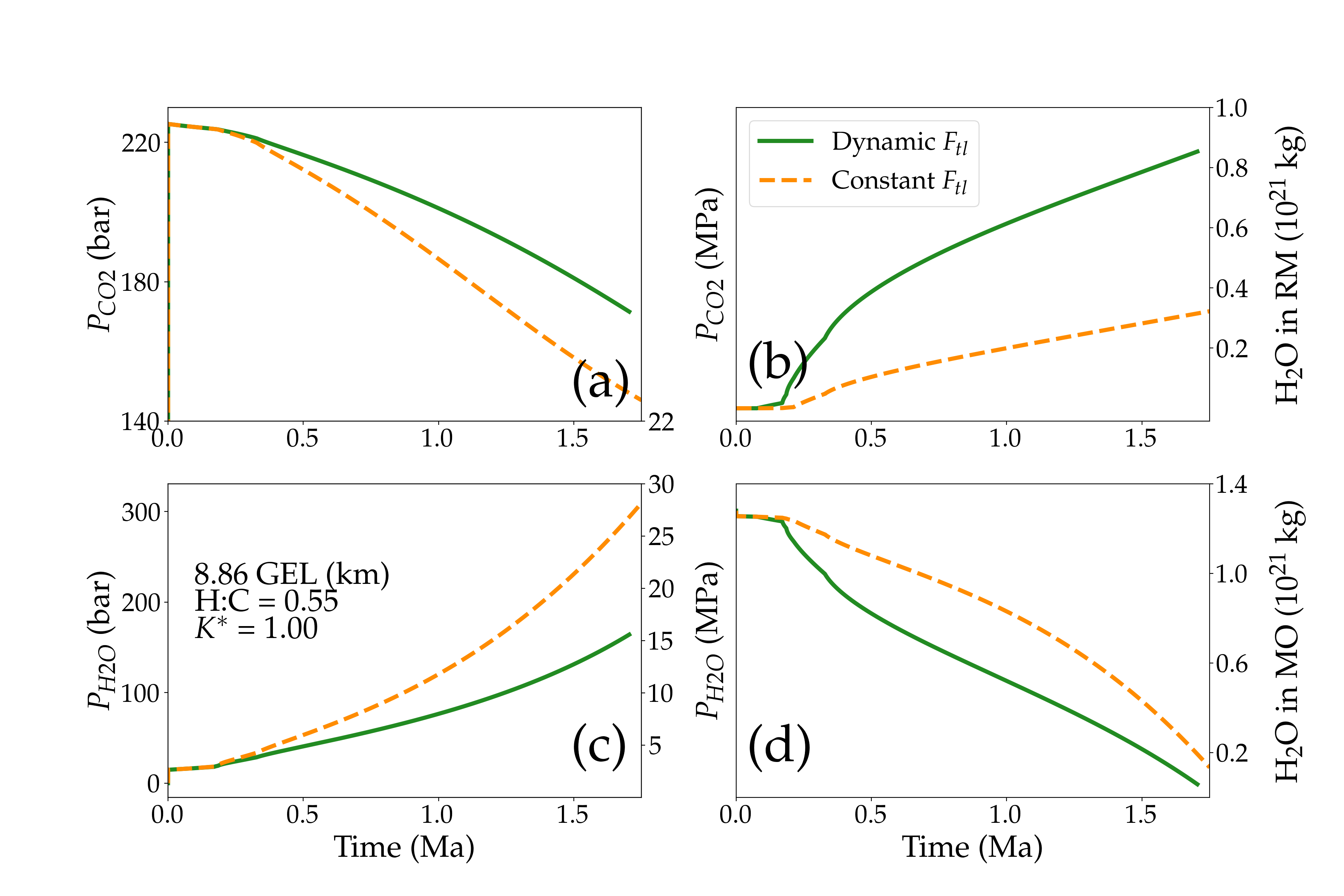
Volatile trapping during magma ocean crystallization on Mars
Immediately following core formation on Mars, the planet underwent a magma ocean (MO) phase. Volatiles released from the MO fostered a primitive atmosphere (PA) which modulated heat loss from the cooling planet through the greenhouse effect. The solidification and degassing of the MO are therefore coupled. In this work, we investigate two important aspects of this evolution: 1) the dynamics of melt trapping at the freezing front of the residual mantle (RM) and 2) the oxidation state during crystallization. For crystallization rates applicable to the martian MO, compaction is inefficient, leading to large fractions of melt trapped together with the crystals accumulating in the RM. The $H_2O$ content of the martian RM is strongly influenced by dynamic melt trapping. Following MO crystallization, up to 55.4% of the initial $H_2O$ in the MO is sequestered in the RM, with the rest outgassed to the surface. Dynamic melt trapping also limits variations in trace element concentrations and fractionations. Resulting variations in important isotopic parent/daughter ratios (Sm/Nd, Lu/Hf) cannot account for all of the isotopic diversity inferred for martian basalt source regions, hence requiring alternative mechanisms. The redox state of the MO exerts a strong control on the total $CO_2$ content of the RM and the time of crystallization. Under oxidizing conditions, the residual mantle stores 0.01% of the delivered $CO_2$ but under the most reducing conditions we examined, the residual mantle can sequester 80.4% in the form of trapped carbonated melt and graphite/diamond.
Resources
Software
Organizations
- Computational Infrastructure for Geodynamics (CIG)
- American Geophysical Union (AGU)
- European Geophysical Union (EGU) Geodynamics
- Extreme Science and Engineering Discovery Environment (XSEDE) (Retired - Now ACCESS)
- Advanced Cyberinfrastructure Coordination Ecosystem: Services & Support (ACCESS)
- National Science Foundation (NSF), NSF Resource Center, NSF Active CSEDI Awards
- National Aeronautics and Space Administration (NASA)
Instruction
- Science Education Resource Center (SERC) at Carleton College
- Center for Teaching and Learning (CTL) at Georgia Tech
- The Chronicle of Higher Education
- Center for the Integration of Research, Teaching and Learning (CIRTL)
Workshops
Lectures/Tutorials/Articles
- 50 years of Plate Tectonics: Parisian Collège de France 2018, Lamont 2016, Geological Society
- ADVANCEGeo: Empowering (geo)scientists to transform workplace climate
- National Parks and Plate Tectonics
- URGE: Unlearning Racism in Geosciences
- XSEDE Video tutorials
- Intro to HPC
- Georgia Tech Vertical Integrated Project HPC
- Scientific Colormaps
- “Consistent Thermo- and Geo-dynamics” by Cian Wilson, Carnegie Science
- Nature Racism special issue
Writing
Art/Outreach/Other fun stuff
- Science.Art.Wonder!
- Math Magazine by 8th Grader Mary Jones


